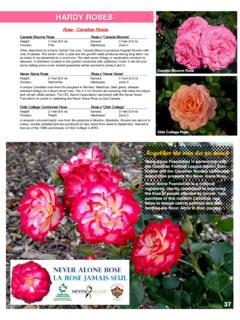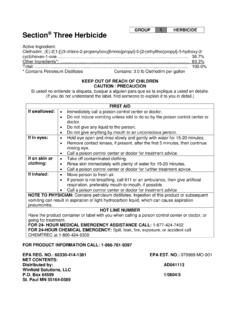Transcription of Poultry Production Guide for a 500 Layer Operation
1 Poultry Production Guide for a 500 Layer OperationManuel V. Duguies, Victor T. Artero, and Jeff D. T. BarcinasForeword | iRevised Forward - February 2016management of Poultry as well as record-keeping and marketing tips. As mentioned, the Guide should be viewed as a source of basic information. Efforts should be made by Poultry producers to obtain more information regarding recommended Production practices, environmental concerns and issues, and the marketing of Poultry products. For information and assistance on Poultry , contact the College of Natural & Applied Sciences' Extension and Outreach (CNAS E&O).Many thanks to Dr. Hauhouot Diambra-Odi and Dr. Thomas Poole for lending their expertise for the 2016 revised version of this following lists some government agencies and their services that may be of benefit/concern to Poultry producers:Department of Agriculture Import requirements, Government of Guam financial (loan) and marketing assistanceGuam Environmental Waste/manure handlingProtection Agency (GEPA) requirementsGuam Economic Development Financial (loan) assistanceAuthority (GEDA)Farmers Home Administration (FmHA) Financial (loan) Department of AgricultureNatural Resources Waste management Conservation Center (NCRS) and windbreak Department of Small Business Administration (SEA) Financial (loan) assistanceContentsForeword.
2 IIntroduction ..1 Stages of Poultry Production ..3 Related Poultry Production Information ..12 Activity Report Charts ..24 Expense and Sales Report Chart ..26 This revised Guide is for individuals interested in raising Poultry for egg Production , whether on a commercial scale (full or part time basis) or as a hobby, with some financial benefits. The Guide provides basic information to raise a Poultry flock of 500 birds. The information could be adapted for any number of layers one wants to content of the Guide includes a brief description of the different stages of Poultry Production and suggested cultural practices in the Introduction | 21 | Introductionfresh eggs. In addition, many consumers are willing to pay a higher price for local fresh of the demand for local fresh eggs, one can often make a profitable Operation even on a 500 Layer farm. Poultry farming could be treated either as a hobby after a workday or a part-time activity after retirement.
3 For the hobbyist and backyard farmer, it is a source of fun and fulfillment as well as a source of extra income. For the full-time Poultry producer, it is an agri-business activity that provides farm and family income. Overall, Poultry farming provides opportunities for everyone from a hobbyist to a commercial Poultry farmer. Opportunities include the sale of eggs, manure for fertilizer, and hens for stewing after their productive egg sale of eggs could generate significant farm income. After the chickens' laying capacity decreases, usually after two years of egg Production , the chickens could be sold as fresh meat for stewing or for kadon pika (a Chamorro delicacy). Chicken manure contains essential plant nutrients and can be used or sold to crop farmers and plant nurseries as fertilizer or soil farming is not highly labor intensive. The time needed to brood, grow and feed 500 birds or to collect an average of 280 eggs a day at Production can be managed easily.
4 It normally takes one to two hours to feed, clean, and collect eggs daily. Depending on the objectives of the producer, the pleasures of working with Poultry , seeing the chicks grow to produce eggs often cannot only be measured in dollars and food Production , the Poultry industry is generally distinguished by two major enterprises; egg Production and meat Production . In egg Production , the most common shell eggs are from chickens and ducks. In meat Production , the most common birds are frying and stewing chickens, turkeys, ducks and geese. The terms broiler and fryer in Poultry meat Production refer to young and tender meat-type birds. This publication, however, is for Layer or chicken for egg Production . Except when otherwise noted, the use of the term Poultry farming in this publication refers to egg farming on Guam can be an exciting and profitable enterprise. As a business venture, the success and profitability of Poultry farming depends on several major factors including proper cultural practices, dependable source of healthy stocks, a balanced nutrition program, dependable infrastructure, sound financial management practice, and a good marketing the early 1970s, Guam reached a 95 percent self-sufficiency level and even exported fresh eggs to islands within Micronesia.
5 Since the mid-1980s, the island's Poultry industry has declined in Production levels due to the closure of some fairly large Poultry operations. In the 1990s, the situation changed significantly with Production trends shifting from large commercial operations to small backyard-type Poultry Production units. The average small Production unit ranged from 100-500 birds. At present, UOG s College of Natural & Applied Sciences Triton Farm is the only existing Poultry Operation on Guam. There have been lots of inquiries on egg Production over the years but none of these have materialized. High cost of commercial feeds and environmental policies on waste management could be some of the reasons why the egg industry has not developed at this eggs are in heavy demand on Guam. Consumers on Guam have a preference for locally-produced fresh eggs over imported Poultry Production Guide for a 500 Layer Operation | 43 | Poultry Production Guide for a 500 Layer OperationStages of Poultry ProductionPoultry operators generally categorize their Operation into five major stages (Table 1).
6 These stages signify the age of the birds in relation to their 1) growth, 2) space requirement, and 3) recommended type of feed. Table 1 lists the five stages of Poultry Production with corresponding bird ages, while the discussion that follows provides information on essential management practices. Additional information on types of feed for each corresponding growth stage can be found on the Feeds and Feeding section of this 1. Five Stages of Layer to 6 weeksGrowing6 to 12 weeksPullet12 to 20 weeksLaying20 to 120 weeksReplacement Process80th weekThe Brooding StageBrooding refers to the early growing period of chicks. The brooding period extends from day-old to six weeks of age. The recommended feed for brooding Layer chicks is Layer starter. Brooding facilities range from litter brooding to battery litter brooding, chicks are placed on the floor that is covered with litter materials such as sawdust, rice hulls, shredded newspaper, or any absorbent material.
7 The chicks are maintained with very few problems. At least 550 square feet would be needed to brood and grow 500 litter needs to be maintained throughout the brooding period. Litter should be at least 4-6" thick. Litter materials recommended for Guam's conditions include sawdust, shredded newspaper, and shredded cardboard boxes. Wet and caked litter must be replaced with fresh litter is recommended that the chicks be brooded in groups of 100. The grouping makes observation easier as well as prevents piling-up (chicks stepping on each other) which can lead to option for the Poultry producer is the use of a battery brooder. The battery brooder could either be constructed or purchased from commercial livestock outlets or catalogs. A battery brooder is made up of wire cages, supported by either wooden or steel legs. The battery brooders could be stacked up to three to four compartments (see Fig. 1). However, a plyboard or similar material must be placed underneath each compartment to catch the manure.
8 The recommended compartment size is 3' wide, 4' long and 14" high. The distance between compartments should approximately be 14". You can request a special order for commercial brooders through your local feed stores. Fig. 1. Battery is recommended that newspapers be placed on the wire floor during the first week of brooding so the toes of the chicks won't go through the holes and to prevent draft from below the brooder. The newspaper bedding should be replaced each time it gets too wet. Cardboard materials may used in place of Production Guide for a 500 Layer Operation | 65 | Poultry Production Guide for a 500 Layer OperationRecommended Brooding PracticesThe following recommended management practices are provided to ensure a good head Two weeks prior to chick arrival, the brooder, waterer, feeder, litter, and other materials for brooding should be cleaned and sanitized. Use a one-gallon capacity waterer for every 50 chicks. The use of a narrow lid base waterer will help prevent chicks for getting into the water.
9 Chicks are very thirsty upon arrival and tend to dive into the water. Once they get too wet, they chill and die. Wet chicks must be put under heat until they are dried. Start feeding 1-2 hours after arrival. Use the chick carton as feeders for the first three days. Provide a small amount of feed each time to avoid wastage. Use galvanized feeders when chicks are consuming a greater volume of Effort needs to be made to protect chicks from predators such as the brown tree snake, rats, cats, and dogs. Chicks are especially susceptible to the attack of the brown tree snake. Brown tree snakes are the predator credited with the reduction and/or extinction of Guam's native bird population. To ensure greater protection from snakes as well as rats it is recommended to use 1/4" x 1/4" wire mesh enclosed brooders/coops. Also, seal off any openings in the Two days before chicks arrive, the brooder must be set up properly. Preparation of the brooder for chick arrival is most important.
10 It becomes the key to the success of a Poultry Operation . The chicks' health and environmental conditions becomes a major concern during the preparation of the brooding facility. If utilizing a used brooder, clean with ammonia and water solution. Also, ensure that the water in feed troughs (containers) is from potable sources. 4. Starter feeds and water soluble antibiotics should be available and stored (per label instructions) for use during the growing period. Use Layer starter feed. Starter feeds are normally medicated to prevent common baby chick diseases like coccidiosis and bacteria that can cause wet droppings. Treat water with soluble antibiotic for at least five days. Antibiotics can be purchased at local feed stores. It is also advisable to make advance orders for starter feeds and antibiotics from these suppliers when anticipating to brood chicks. Note: If an automatic watering system is used, be sure that a backflow (anti-siphon) device is installed to prevent antibiotics from entering the main water line.


